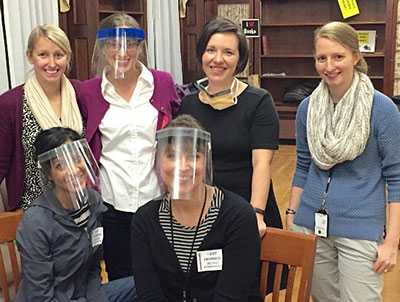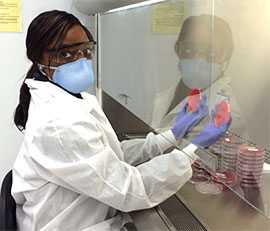Division of Bacterial Diseases (DBD) News Bulletin
Summer 2015
In This Issue
- Exploring Meningococcal Outbreaks & Carriage
- White House Forum on Antibiotic Stewardship
- New EIS Officers & LLS Fellow
- DBD Supports the Ebola Response
- MenAfriNet Partners Respond to Niger Outbreak
- Laboratory & Communications
- Vaccine News & Meetings
- Awards
- Epi-Aids & Outbreak Investigations
- Publication Highlights

Photo: Members of the MVPDB swabbing and enrollment team from the carriage evaluation at a Rhode Island university in February 2015. From left to right, top to bottom: Amy Blain, Sarah Meyer, Amanda Faulkner, Lucy McNamara, Manisha Patel, and Anna Acosta.
Exploring Meningococcal Outbreaks and Carriage with Whole Genome Sequencing

Photo: Marsenia Harrison, in DBD’s Pertussis and Diphtheria Laboratory, examines agar plates inoculated with oropharyngeal swabs for bacterial growth from the Rhode Island outbreak, February 2015.
Typically, there is less than a one in a million chance of getting serogroup B meningococcal disease. However, in February 2015, students at a small university in Rhode Island found their odds increasing to approximately one out of every 2,500 after just two students, with no known contact to each other, came down with the disease. Soon after, a separate outbreak of serogroup B meningococcal disease occurred at a large university in Oregon. Over the course of four months, these outbreaks sickened nine individuals and tragically resulted in one death.
Between October 2014 and January 2015, two serogroup B meningococcal (MenB) vaccines were licensed in the United States allowing universities to quickly respond to outbreaks by vaccinating their students. These vaccines help protect against one type of the germ that causes meningococcal disease, Neisseria meningitidis serogroup B.
An important benefit of some vaccines is their ability to also protect against the carriage of germs, which can lead to the establishment of herd immunity. Carriage is when people have N. meningitidis in the back of their nose and throat with no signs or symptoms of disease. It is believed that about one out of every 10 people carry N. meningitidis, but it is not known if the new MenB vaccines affect carriage. Vaccine campaigns at these universities in response to these two outbreaks offered a unique opportunity to observe the effects of MenB vaccination on carriage, identify the germs in circulation, and investigate general carriage rates of N. meningitidis among U.S. college students.
However, performing carriage studies in no easy task. In this case, it required analyzing thousands of samples collected from students. In the past, a lab technique known as pulse-field gel electrophoresis (PFGE) was used to compare the DNA of N. meningitidis strains to see if there were genetic links. This process is time-consuming, labor intensive, and limited in the results it can provide. DBD’s Bacterial Meningitis Laboratory, with aid from the Biotechnology Core Facility Branch and National Center for Immunization and Respiratory Diseases’ Bioinformatics Support Team, investigated the two outbreaks and subsequent carriage studies using whole genome sequencing (WGS) in order to better understand outbreak strains and carriage at these
universities. WGS allowed for more sophisticated, in-depth strain comparison between the germs found in carriers and those that caused the outbreak. WGS also allowed the lab to see if there is any connection to strains that have been seen on other college campuses in the past few years.
“Both on-site and in-house processing of the samples required dedication and long hours of work every day and night,” recalls DBD’s Bacterial Meningitis Laboratory Director Xin Wang. “The Bacterial Meningitis Laboratory team and participating members from the Microbial Pathogenesis and Immune Response and Pertussis and Diphtheria Laboratories rose to the challenge and completed the work quickly.”
A final round of each carriage study will be held in fall 2015, at which point, CDC will look to see if the new MenB vaccines have had an impact on the carriage of N. meningitidis.
Director’s Spotlight
Regards from Rana…
Dear colleagues,
It has been months since we had our last Bulletin. This year has been very busy for DBD and the size of this Bulletin reflects all our hard work. We supported numerous meningococcal and Legionnaires’ disease outbreaks and launched carriage studies and a very impressive Advanced Molecular Detection program. We worked with ACIP to support recommendations for pneumococcal and serogroup B meningococcal vaccines, published over 30 manuscripts, conducted many interviews, and developed new tools to increase public awareness about bacterial diseases and our work. As usual, DBD staff received some of CDC’s highest civil service honor awards and recognitions and were invited to present at conferences around the world. We also enhanced our MenAfriNet activities and assisted with setting up the agency’s new Global Health Security Initiative.
In the spring, our Get Smart program reached out to its network of partners to support CDC’s role in the White House Forum on Antibiotic Stewardship. Sadly, as the agency moves to implement the U.S. National Action Plan for Combating Antibiotic-Resistant Bacteria, the Get Smart program has been transitioned into the Division of Healthcare Quality Promotion. DBD and NCIRD built a strong program that will contribute immensely to the Antimicrobial Resistance Initiative and to DBD’s activities in this field.
We can all be proud of the number of DBD staff who stepped forward to reinforce the agency’s Ebola response, both abroad and here at home. In this Bulletin, some of our staff and I share our experiences supporting this global public health priority. Our involvement in “Getting to Zero” included epi and lab staff from both branches, along with communications, policy, and tactical administrative support from the office of the director. Staff were involved in helping to launch the STRIVE Ebola vaccine trial.
Please take a few minutes to read about all that is happening in the Division, and congratulate your colleagues, and get to know our new staff members. As always, I am deeply appreciative of all of your efforts.
-Rana
- Page last reviewed: September 28, 2015
- Page last updated: September 28, 2015
- Content source:


 ShareCompartir
ShareCompartir